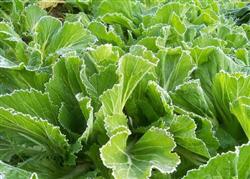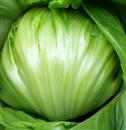How to grow mustard?

How to grow mustard? Please refer to the following methods for the cultivation of mustard in detail: 1. Soil selection and soil preparation the previous crops of root mustard should generally be melons, legumes and eggplant crops, not with cruciferous crops or land where mustard was planted in that year. Grain and vegetable rotation can also be carried out with grain fields and rice. High yield can be obtained by planting root mustard in loam or clay loam with deep soil layer and rich organic matter. After the previous harvest, 22 500 ~ 30 000 kg of farm manure or compost was applied, and calcium superphosphate 300~375kg, potassium sulfate 120~150kg or plant ash 750kg were added as base fertilizer. The amount of base fertilizer per hectare should be more or less depending on the fertility of the soil. Turn the bottom fertilizer into the soil and mix it well with the soil. The depth of soil ploughing is required to reach 25~30cm. After leveling the land, it can be cultivated as a high border with 1.2m trench, and can be cultivated in mountainous areas and land with good drainage. Second, sowing and seedling root mustard can be used for seedling transplanting or direct seeding. The malformed root of direct seeding mustard is very few, the shape is neat, the yield is high, and the processing quality is good. In order to facilitate management and make full use of land, many places have adopted seedling transplanting and root mustard harvesting. 1. Direct seeding (1) sowing time: the sowing date of root mustard is relatively strict, early sowing is easy to approve of immature bolting, too late sowing is not enough in early vegetative growth, which greatly affects the yield and quality, so it must be sowed in time. However, the sowing date in various places should be determined according to the local climatic conditions. in the south subtropics, most of the seeds are sown between late August and late September. In mountainous areas and places with poor water source conditions, early sowing can be appropriate, and late sowing can be appropriate in fields with convenient irrigation and high soil moisture. (2) sowing method: direct seeding of mustard root is often carried out by hole-on-demand method, and the hole-opening depth is generally 2~3cm. After sowing, fine soil is covered or fine residue fertilizer with plant ash is added. If the field is wet when sowing, there is no need for irrigation; if the soil is dry, it should be watered thoroughly and then covered. When sowing, sow 5-6 seeds per hole. When sowing, the seeds should be scattered in the hole, not in a pile. The sowing amount per hectare is about 1.5~1.8kg. (3) the fleshy root of mustard for sowing density root is the raw material for processing pickled pickles. If the sowing is too dense, the fleshy root is too small to meet the processing standard; if the sowing is too thin, the fleshy root meets the processing standard, but the ideal yield can not be achieved. Therefore, the sowing density of mustard should be determined according to the plant type size and plant development degree of each variety. Generally, the varieties with small plant type and low degree of development have a row spacing of 40 × 50cm, planting 45 ~ 50 000 plants per hectare, while the varieties with high plant type and high degree of development have a row spacing of 50 × 55cm and plant about 37500 plants per hectare. At the same time, sparse or dense planting should be appropriate according to soil fertility and light conditions. The areas with poor soil fertility and little light should be planted sparsely, while the areas with good soil fertility and good light can be planted densely. 2. Seedling transplanting root mustard is cultivated by seedling transplanting in many areas, and seedlings can also be pulled out in the middle of direct seeding field and planted in other fields, and the seedling raising method is the same as other mustard. However, the sowing date of seedlings is about 10 days earlier than that of direct seeding. The time of seedling sowing in southwest and south subtropics is generally from late August to mid-September after the Beginning of Autumn, and the seedling period is about 40 days. When raising seedlings, we should pay attention to proper sparse sowing and inter-seedling, so that the spacing of each seedling is about 7cm, and keep a certain nutritional area of each seedling, so that strong seedlings can be cultivated for planting. The suitable planting period is from late September to mid-October. When planting, plant according to the plant row distance of the variety, plant a strong seedling in each hole, require the straight root to be perpendicular to the center of the hole, fill with fine soil, pour the fixed root water thoroughly after planting, and water it once or twice before delaying the seedling until all survive. 3. Field management (1) seedlings and seedling roots can emerge neatly after 3-5 days after sowing with mustard. About 20 days after emergence, two leaves can be seen, and seedlings should be carried out. 3 dwarf strong seedlings are left in each hole of direct seeding and keep a certain distance from each other, and if they grow for another 10-15 days, the seedlings will be fixed, and only one healthy seedling will be left in each hole. When fixing the seedlings, we should pay attention to the characteristics of the variety and get rid of the bad and false to stay true, and use the strong seedlings pulled out to fill the lack of holes. Make up the hole of the seedling, should bring the soil to fill, cannot hurt the root, guarantee the survival of the seedling at one time. When the seedlings are planted in the seedling bed for about 20 days, the seedlings should be separated for 1 or 2 times, and the seedlings in the dense places should be pulled out to keep the seedlings in the seedling bed uniform and strong. When planting, the seedling bed should be watered thoroughly, and then the seedling belt soil should be planted in the field according to a certain plant spacing. 2. Topdressing, irrigation, weeding and direct seeding when the seedlings see two leaves in one mind, the first fertilizer should be applied after interseedling ploughing and weeding at the same time. This topdressing is mainly for raising seedlings and should be applied lightly. 15000 kg of farm manure water per hectare should be applied with 45~60kg urea, and should be mixed with clear water. After seedling setting, the second intertillage weeding and the second topdressing should be carried out. This topdressing is to lay a nutritional foundation for the expansion of fleshy roots. It can be slightly thickened by 22500 kg of farm manure water per hectare, mixed with urea 60~25kg and potassium sulfate 75~90kg, and about 15 days after seedling setting, the third intertillage weeding and weeding will be carried out, followed by the third topdressing, with farm manure water 22500kg, urea 75~90kg and potassium sulfate 90~120kg per hectare. At this time, the rainy season is over and irrigation should be carried out in combination with fertilization. In the future, topdressing should be applied for 2 or 3 times according to the seedling condition, especially in the period of fleshy root expansion. In the whole growing period, the principle of fertilization is first light then heavy, first light and then thick. Irrigation should be carried out frequently with small water, do not flood irrigation, and must be irrigated according to the weather and soil drought. Intertillage weeding is generally carried out for 3 or 4 times, the first time is shallow and middle ploughing, the second time is deep ploughing 10~15cm, the third time is shallow ploughing, and the fourth time is light intertillage according to seedling condition to remove weeds. (3) the phenomenon of immature bolting is often found in the main producing areas of mustard from late October to December, but the reason is not fully understood. In case of this phenomenon, you can take off the bolt at any time. After the root is removed, the fleshy root of mustard can still be expanded, but the sooner it is picked, the better. Therefore, the field should be inspected frequently from October to December, and it was found that the removal of the bolting of one plant was beneficial to the neat expansion of the fleshy root of mustard. (4) the main pests of root mustard are green insects and aphids, and the diseases are mainly virus diseases. These diseases and insect pests are general diseases and insect pests of cruciferous vegetables, which can be carried out with reference to the pest control methods of Cruciferae. Third, the harvest root is harvested from mustard sowing to fleshy root harvesting, depending on the variety and local climatic conditions, the general fleshy root has been fully expanded to be harvested before the appearance of flowers and moss. The sign of maturity is that the basal leaves are withered and yellow, and the root head changes from green to yellow. When harvesting, the root is dug up with mustard with a hoe, and then the lateral root of the stem and leaf is cut off with a sharp knife, which can be shipped to the market or processing plant for sale. Click to get more mustard planting techniques click to get more vegetable planting techniques
- Prev

How to grow big meat heart mustard?
How to grow big meat heart mustard? Please guide big meat heart mustard, also known as Chaozhou mustard, has a long history of cultivation. Its juice is rich and crisp and of good quality. in addition to fresh food, it is also suitable for submerged pickles. It is an excellent vegetable species to make full use of winter idle land after late rice harvest. The cultivation techniques are as follows. First, sow winter.
- Next

How to fertilize the root with mustard?
How to fertilize the root with mustard? Please introduce the method of root mustard fertilization can refer to the following methods: 1. The application of basic fertilizer root mustard like the land rich in organic matter, so be sure to apply a sufficient amount of organic fertilizer before soil preparation, generally can use farm manure or pile of municipal waste, and then add plant ash and over.
Related
- Where is it suitable to grow horseradish in China? it is expected to see the middle altitude horseradish in Alishan.
- How to prevent tomato virus disease reasonably? (Control methods included)
- Many people like to plant towel gourd on the balcony. What are the main points of this method and management?
- What crops can chili peppers be mixed with?
- Fertilization techniques and matters needing attention in Tomato
- What are the grafting techniques for peach seedlings in spring?
- Harm and control methods of root swelling disease of Chinese cabbage
- What are the pests of sweet potatoes? How to prevent and cure it?
- Symptoms, causes and Control methods of navel Rot in Tomato
- The cause of "Cucumber rotten bibcock" in Farmers' planting Cucumber and its Control Plan

